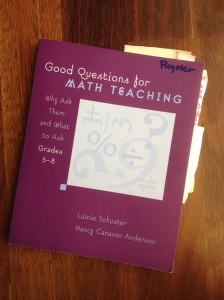I’ve seen a lot of MTBoS buzz about the book 5 Practices for Orchestrating Productive Mathematics Discussions by Mary Kay Stein and Margaret Schwan Smith. It’s a great book that offers practical advice on getting the most out of discussions in the classroom. But in order to have a great discussion, you need to start with a great question. Where do you find good questions to ask?
One of my favorite resources for good, open-ended questions is the book Good Questions for Math Teaching: Why Ask Them and What to Ask, Grades 5-8. (And there is a K-6 version as well.) Here’s the description from the back of the book:
“Good questions”—or open-ended questions—promote students’ mathematical thinking, understanding, and proficiency. By asking careful, purposeful questions, teachers create dynamic learning environments, help students make sense of math, and unravel misconceptions.”
My own copy currently has sticky notes marking a bunch of questions I want to use or that I’ve used in the past. (Am I the only crazy person who will forget to use a resource if I don’t have a visual reminder of it?!)
The book is 195 pages long, and the questions start on page 17 — this is a book FULL of questions you can use right now in your classroom. But if you’re looking for a resource for questions with an answer key, this isn’t it. I love that, because teachers should be anticipating their students’ strategies and misconceptions (the first of the 5 Practices). It’s so much easier to anticipate what students will do if you’ve gone through the process of answering the question yourself! But the book does offer commentary after each question, outlining potential problem areas, giving justification for using the problem, or offering suggestions for implementing the question effectively.
The questions are organized by seven strands that should easily align with CCSS standards: Number Relationships; Multiplication and Proportional Reasoning; Fractions, Decimals and Percents; Geometry; Algebraic Thinking; Data Analysis and Probability; and Measurement. Within those strands, questions are subdivided into suggested grade levels (5-6 or 7-8), but don’t limit yourself to “your” grade level when identifying good questions to use!
This question led to a very prouctive discussion in my 6th grade classroom last year. It would have also made a great journal or INB prompt:
Which of the following problems has the largest product? Try to figure it out by solving as few problems as possible. How did you choose which problems to do or not to do?
42 x 17
24 x 12
52 x 11
40 x 20
50 x 24
43 x 16
36 x 36
12 x 14
42 x 42
This week’s #MSSunFun prompt was to share a “go to” blog or website, but this book is such a good resource that I wanted people to know about it. Where do you find good questions for discussions or journal prompts?


Comments on: "Want a good discussion? Ask a good question." (1)
[…] Alisan Royster, @G8rAli, Want a good discussion? Ask a good question. […]